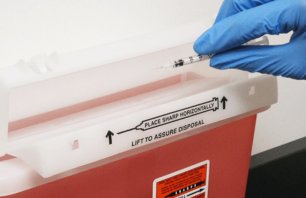In September of 2022, the US Environmental Protection Agency (EPA) released an update to its 10-Step Blueprint for Managing Pharmaceutical Waste in US Healthcare Facilities (The Blueprint). The Blueprint provides a simplified overview for healthcare organizations of EPA’s hazardous waste pharmaceutical regulations (known as Subpart P) and other relevant requirements for managing pharmaceutical waste.
Below are a few key topics covered in The Blueprint, but Stericycle recommends that you review it in its entirety. As you review The Blueprint, it is important to cross-reference Subpart P, other applicable federal regulations, and your state’s requirements.
Waste Determinations
As a first step, all generators should conduct a waste determination to help ensure the appropriate management of pharmaceutical waste. As part of a waste determination, you need to consider questions, such as whether the pharmaceutical waste is hazardous or non-hazardous and whether it is controlled or non-controlled. Your state’s regulations or your facility’s policy may dictate the evaluation of additional criteria. You should also always confirm with your waste vendor and other partners what types of material they will or will not accept.
Adoption of Subpart P & the Nicotine Exemption
In states that have adopted Subpart P, adherence to that rule is required for Small Quantity Generators (SQGs) and Large Quantity Generators (LQGs). Very Small Quantity Generators (VSQGs) are not required to follow Subpart P but may opt to do so. Generators that are required, or opt to follow Subpart P, must submit the 8700-12 Form. Be sure to confirm whether your state has adapted the Nicotine Exemption because it is optional for states.
All generators in all states must adhere to the “sewering ban” in Subpart P, which prohibits any hazardous waste pharmaceuticals from being disposed of down the drain. Further, in The Blueprint, the EPA recommends the collection of all pharmaceutical waste via a waste management program and “encourages healthcare facilities to discontinue drain disposal of all pharmaceutical waste, whether or not it meets the definition of an RCRA hazardous waste.”
Empty Containers & Residues of Hazardous Waste Pharmaceuticals
Under Subpart P, any residues of hazardous waste pharmaceuticals in empty containers do not require management as hazardous waste as long as the containers have been emptied using practices commonly employed to remove materials for the container type (e.g., all pills have been removed from a package, the plunger of a syringe has been fully depressed, an IV bag has been fully administered to a patient, etc.). Review all relevant regulations as there may be other requirements.
Controlled Substances that are also Hazardous Waste Pharmaceuticals
The Drug Enforcement Administration (DEA) regulates controlled substances, including the disposal of controlled substances by registrants such as dispensers or practitioners. Some pharmaceutical waste may be both hazardous waste regulated by EPA and a controlled substance regulated by DEA. Depending on your facility’s activities, your State Board of Pharmacy may also regulate your pharmaceutical waste management practices.
Further, hazardous waste pharmaceuticals can be separately regulated in transport (by the U.S. Department of Transportation, or DOT) and at the treatment/end disposal facilities (by EPA and other environmental regulators).
This overlap of regulatory regimes can be daunting. To help address this, Subpart P includes a conditional exemption for hazardous waste pharmaceuticals that are also controlled substances. Such material does not necessarily need to be managed as hazardous waste if certain conditions are followed, including that the material is collected, stored, transported, destroyed, and disposed of in compliance with all applicable DEA regulations. Keep in mind that even with the EPA’s conditional exemption, you must follow any DOT, treatment, and end disposal facility requirements.
Learn more about how Stericycle can help with your pharmaceutical waste management.



